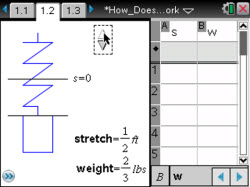How Does a Spring Scale Work?

How Does a Spring Scale Work?
In this lesson, teachers will use a spring to help students learn that the constant of proportionality between two proportional quantities is the unit rate of change.
- Students will discover that the constant of proportionality between two proportional quantities is the unit rate.
- Students will discover that the unit rate is the slope of the line.
- ratio
- proportion
- unit rate
- slope of a line
- constant of proportionality
This lesson involves students using the emulation of a spring scale stretched by a weight to record and graph the direct proportional relationship between the weight and the stretch.
As a result students will:
- Observe and analyze changes in the stretch of the spring as weight is added to the spring.
- Compute the constant of proportionality for the weight-to-stretch relationship.
- Compute the unit rate associated with the ratio of weight and spring stretch, which is equal to the strength of the spring scale.
- Determine that for directly proportional quantities, the constant of proportionality is equal to the unit rate of change associated with the quantities, and is equal to the slope of the line of best fit for the data.
Note: the activity simulates a well known physics phenomena called Hooke’s Law that states the extension of an elastic spring is directly proportional to the load applied to the spring.
Vernier EasyData,Vernier EasyLink and Vernier EasyTemp are registered trademarks of Vernier Science Education.

